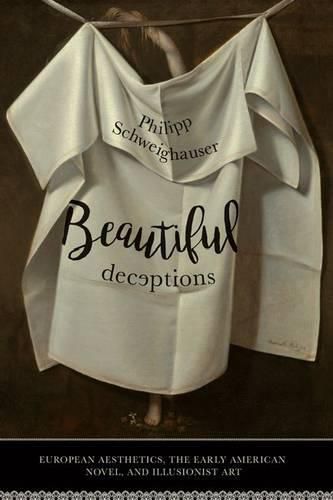Readings Newsletter
Become a Readings Member to make your shopping experience even easier.
Sign in or sign up for free!
You’re not far away from qualifying for FREE standard shipping within Australia
You’ve qualified for FREE standard shipping within Australia
The cart is loading…






The art of the early republic abounds in representations of deception: the villains of Gothic novels deceive their victims with visual and acoustic tricks; the ordinary citizens of picaresque novels are hoodwinked by quacks and illiterate but shrewd adventurers; and innocent sentimental heroines fall for their seducers’ eloquently voiced half-truths and lies. Yet, as Philipp Schweighauser points out in Beautiful Deceptions, deception happens not only within these novels but also through them. The fictions of Charles Brockden Brown, Hugh Henry Brackenridge, Susanna Rowson, Hannah Webster Foster, Tabitha Gilman Tenney, and Royall Tyler invent worlds that do not exist. Similarly, Charles Willson Peale’s and Raphaelle Peale’s trompe l'oeil paintings trick spectators into mistaking them for the real thing, and Patience Wright’s wax sculptures deceive (and disturb) viewers.
Beautiful Deceptions examines how these and other artists of the era at times acknowledge art’s dues to other social realms-religion, morality, politics-but at other times insist on artists’ right to deceive their audiences, thus gesturing toward a more modern, autonomous notion of art that was only beginning to emerge in the eighteenth century. Building on Alexander Gottlieb Baumgarten’s definition of aesthetics as
the science of sensuous cognition
and the writings of early European aestheticians including Kant, Schiller, Hume, and Burke, Schweighauser supplements the dominant political readings of deception in early American studies with an aesthetic perspective. Schweighauser argues that deception in and through early American art constitutes a comment on eighteenth-century debates concerning the nature and function of art as much as it responds to shifts in social and political organization.
$9.00 standard shipping within Australia
FREE standard shipping within Australia for orders over $100.00
Express & International shipping calculated at checkout
The art of the early republic abounds in representations of deception: the villains of Gothic novels deceive their victims with visual and acoustic tricks; the ordinary citizens of picaresque novels are hoodwinked by quacks and illiterate but shrewd adventurers; and innocent sentimental heroines fall for their seducers’ eloquently voiced half-truths and lies. Yet, as Philipp Schweighauser points out in Beautiful Deceptions, deception happens not only within these novels but also through them. The fictions of Charles Brockden Brown, Hugh Henry Brackenridge, Susanna Rowson, Hannah Webster Foster, Tabitha Gilman Tenney, and Royall Tyler invent worlds that do not exist. Similarly, Charles Willson Peale’s and Raphaelle Peale’s trompe l'oeil paintings trick spectators into mistaking them for the real thing, and Patience Wright’s wax sculptures deceive (and disturb) viewers.
Beautiful Deceptions examines how these and other artists of the era at times acknowledge art’s dues to other social realms-religion, morality, politics-but at other times insist on artists’ right to deceive their audiences, thus gesturing toward a more modern, autonomous notion of art that was only beginning to emerge in the eighteenth century. Building on Alexander Gottlieb Baumgarten’s definition of aesthetics as
the science of sensuous cognition
and the writings of early European aestheticians including Kant, Schiller, Hume, and Burke, Schweighauser supplements the dominant political readings of deception in early American studies with an aesthetic perspective. Schweighauser argues that deception in and through early American art constitutes a comment on eighteenth-century debates concerning the nature and function of art as much as it responds to shifts in social and political organization.